Somers class Destroyers (1937)
 US Navy Large Destroyers (1937-48):
US Navy Large Destroyers (1937-48):
USS Somers, Warrington, Sampson, Davis, Jouett, DD-381-86
The Somers-class were a class five large destroyers built for the United States Navy in the 1930s, large fleet destroyers as the previous Porter, intended to deal with the Japanese “special types”. Named after naval heroes they were commissioned between 1937 and 1939 with the same heavy armament but also twelve 21-inch torpedo tubes and a more modern machinery designed by Gibbs & Cox. Suffering the same stabiliy issues, two were later rebuilt. They all saw extensive service between the Atlantic, Mediterranean and Pacific as convoy escorts, only earning collectively 6 battle stars. Only Warrington was lost, due to a hurricane north of the Bahamas on 13 September 1944. #ww2 #usn #USnavy #destroyer #somers
Design of the class
The Somers class was not just a repeat of the Porters. They were still originally designed as answers to the large “special type” IJN destroyers and initially intended to be flotilla leaders. Instead of 1400 they went for a 1850 tonnes standard hull according to the London Treaty, which proved still too light for their heavy armament. The admiralty however gave te Porter design to modify to Gibbs & Cox naval architects from New York. The Modifications included new high-pressure and high-temperature boilers allowing the truncating of exhausts into a single stack and weight savings like the removal of reload torpedoes and addition of a third torpedo tube banks in exchange (12 instead of 8), but they were still over-weight and top-heavy.
Hull and general design
As a “repeat porter” all that was said about the latter class was still true. The Somers looked like “mini cruisers” with their four twin turret main armament. But they weight-saving measures had the Porter’s tripod masts removed and she only shared the hull and main superstructure bridge and aft tower intact, but now they were caracterized by their single pole mast aft of the bridge and single funnel, making them immediately standing out from other USN destroyers, like an overgrown version of the Bagleys. The new boilers enabling a single stack, added to weight savings like reload torpedoes had a reward for the admiralty: The installation of an extra quadruple centerline torpedo tube mount, making for three banks and given their particular placement allowing them to all fire on the same broadside, enabled the largest toprpedo broadside of any USN destroyer so far, better than even the four-banks Bagley-Gridley-Benshams serie.
The hull design was a repeat of the Porters, an enlarged, elongated version of the Farragut’s, with a forecastle extended by bulwarks for sea keeping. It measured 381 ft (116 m) overall by 36 ft 2 in (11.02 m) in beam and a mean draft of 10 ft 4 in (3.15 m). There was a superstrcture forward supporting the superfiring “B” twin turret, followed by a raised platform for a quad AA mount, and a two-level bridge with the caracteristic prismatic shape, its wings supported by the structure below. The hull displaced 1,840 tons standard and 2,767 tons fully loaded. It is unsure if measures has been taken for stability concerning their fuel tanks placement and drainage.
The amdiship section, aft of the funnel, comprised three elevated mounts for the triple TT banks, one axial aft of the single funnel, and two other broadside, in échelon. The hull aft section comprised a deck quartederck strcuture supporting a two-levels aft tower for the aft fire control turret, a short mast to carry the hanging radio cables, the aft projector, aft AA quad mount, and “C”, “D” turrets in a superfiring pair.
Powerplant
The Somers class were the first US destroyer to use 600 psi (4,100 kPa) steam superheated boilers, with a temperature ported to 850 °F (454 °C), standard for US warships built in the late 1930s. They were shared notably by the rebuilt Battleships if the New Mexico class.
The ships had two shafts, driven by General Electric geared steam turbines, with cmbined low pressure, high pressure (LP, HP) sections.
They were fed by four Babcock & Wilcox boilers. This ensemble produced an output of 52,000 shaft horsepower (39,000 kW) as designed, and up to 53,271 shaft horsepower (39,724 kW) on trials (50,000 shp (37,000 kW) for the Porters and 37 knots).
This in turn allowed a speed as designed of 36 knots (67 km/h; 41 mph) but they reached 38.6 kn (71.5 km/h; 44.4 mph) on trials.
The propellers were likely a repeat of the Porter’s, bronze type, true screw, with solid (cast) manganese bronze made by New York shipbuilding (three bladed), diameter 11 feet and with variable pitch on 15 inches diameter shafts.
Range was comparable to the Porters, but greater, at 7,020 nmi (13,000 km; 8,080 mi) at 12 kn (22 km/h; 14 mph) cruise speed, versus 6,380 nm.
Armament
The same armament -except the torpedo tubes- was repeated. the goal was still to outmatch a special type destroyer in a gunnery duel. For this, they carrier a “cruiser-like” four twin turret arrangement. These were special mounts, only enabling a limited elevation and made for surface engagements only, but the same 5-in/38 guns shared by the USN.
Main: 4x 5-in/38 Mark 12, Mounts Mark 22
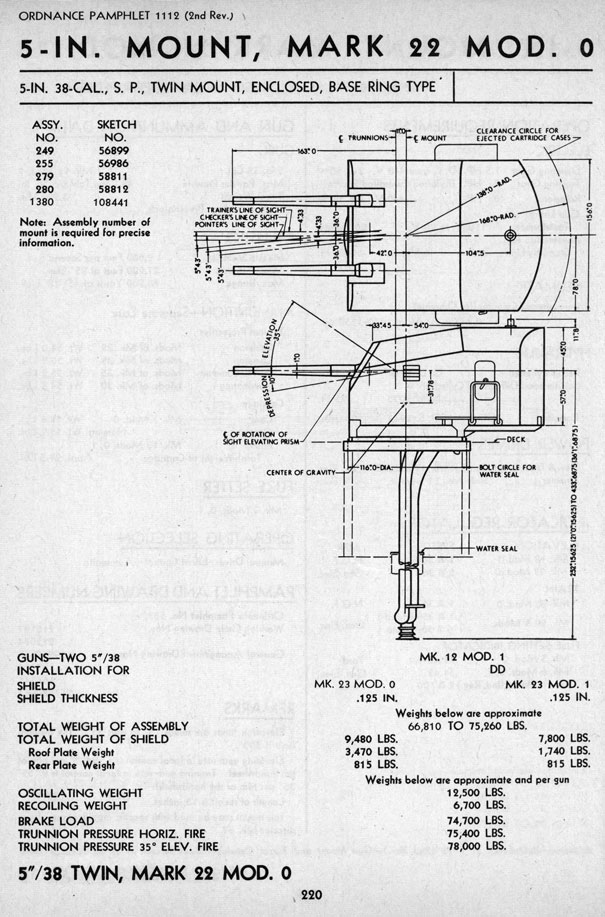
Mark 12/Mk 22 Mount turrets fully enclosed turrets – sketch from OP-1112, HNSA
The Mark 22 turret was unique to the Porter-Somers classes leaders. The four Mark 22 single purpose twin enclosed mounts were adopted to save weight with a simple gun cradle and compact turret compared to the Dual Purpose ones.
The Mark 22 was manufactured to 52 units, enough for 13 destroyer leaders of both class, provided with a first batch of 104 barrel plus spares.
They weighted 75,250 lbs. (34,133 tons) apiece, elevated -10 to +35° at 11.6°/sec. with a traverse of 290-330° (at 14.7°/sec.) depending on their position with upper mounts having the clearest arc. For this, they used a 15 hp training motor and 5 hp elevating motor. Guns were separated by 72 inches (183 cm) versus 84 inches (213 cm) to lower shell interference.
Shells were AAC Mark 34 Mod 10 (55.18 lbs./25 kg), 20.75 in (52.7 cm) long and carrying a 7.25 lbs. (3.3 kg) Explosive D or Composition A charge. The complete round had a Brass cartridge 127 x 679 mm, 12.31 lbs. (5.58 kg). 300 rounds were carried for each gun, 2,400 per ship. More on the 5-in/38
Specs: 5-in/38 Mark 12/22:
Max ROF ?
Muzzle velocity 2,600 fps (792 mps)
Effective range 16,739 yards (15,298 m) at 35°
Approx. barrel life 4,600 rounds
Maximum firing range 45° 4,389 m (4,800 yd)
Penetration 5-in (127 mm) at 4,000 yards (3,660 m)
Torpedoes: 3×4 21-in Mark 15
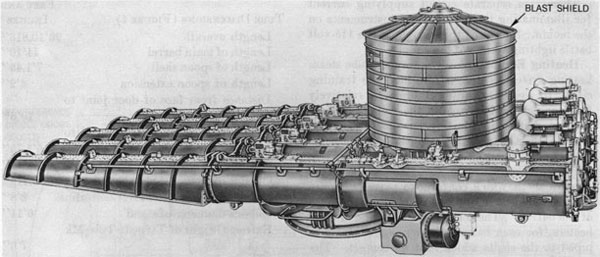
The ships carried when completed the Mark 15 torpedo with a practical broadside of twelve torpedoes depending on the ship’s angle (safe angle) to fire. In addition, the admiralty developed the “curved ahead fire” concept using post-launch gyro angle to enable all torpedoes to curve around and reach the same target. So with some tweaking, two or even four banks could have been mounted side by side as for the Bagley/Gridleys. It was not done for obvious stability reasons, but with more displacement there was a potential for a 24 torpedo “broadside” by leaving a single axial bank. Nevertheless, this was the largest axial torpedo tubes banks configuration of any US destroyer.
Specs, Mark 15:
Weight: 3,438 lbs. (1,55 kg) for 288 inches (7.3 meters)
Range: 6,000 yds/45 knots (5,500m/83 km/h) or 15,000 yds/26.5 knots (13,500 m/49 km/h)
Warhead: TNT Mod.3 HBX 494 lbs. (224 kg), Detonator Mk 6 Mod 13 with contact exploder
Engine: Wet-heater combustion/steam turbine, compressed air tank/Methanol
Guidance system: Gyroscope with settings (for the curve ahead fire)
Anti-aircraft Armament
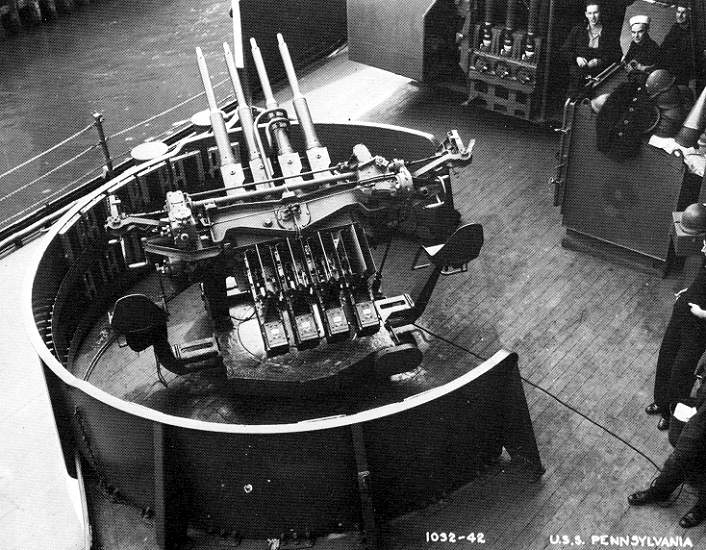
Anti-aircraft (AA) protection comprised two quadruple 1.1-inch “heavy machine guns” mounts, called the “chicago piano”, and two .50-caliber Browning heavy machine guns. The 1.1-inch mounts were jusged inadequate in 1941 and it was planned to replace them asap, as well as removing the Brownings and adding 20 mm oerlikon guns (see later, armament upgrades). More on these.
ASW
The Somers’ anti-submarine warfare suite was classic, with two seven-charges racks at the stern (14 in all). Later four “K-gun” depth charge throwers were added on either side (see later).
This ASW weaponry was completed by the QCA sonar:, early type, spherical and underwater, under the hull. This was Manufactured by CMB. 24 cycles frequenty, M/S spherical projector, 400 Watts, electric hoist and train.
Fire Control and sensors
Mark 35 SP Fire Control Director
Unique to the Porter and Somers, two Mark 35 Fire Directors were carried, “cruiser type” systems made only for surface engagements. They were installed on top of the pilot house and after deckhouse. Heavy fire control for destroyers, they were larger and suited for more range than the ubiquitous Mark 33 director. Wartime reconstruction saw the removal of these to save weight, and replace them with lighter and more versatile Mark 37 or 38 fire control systems.
Radars
Only installed in 1942-43, they received a set of three radars. One was fitted on top of the pole mast, another was used for rangefinding on top of the forward Fire Control Tower, plus an antenna aft. There were the follwing standards:
SC Radar: 220 KW Air/Surface Search, VHF band 60 Hz Bwt 10–25° Pwdt 4–5 μs Range 48–120 km (30–75 mi) @90–180 m (98–197 yd) (Top mast)
SG Radar: 50 KW Surface Searc. Frq 3 GHz PRF 775/800/825, Bmwdt 5.6°/15°, Pwdt 1.3–2 μs RPM 4/8/12, Range 15 nmi @200 yd
Mk 3 radar: Beam width 9°, antenna with sum dipoles length 4 wave lengths. Medium Wave Fire Control for Main Battery. Compatible with the Mark 35 director.
Mk 12.22 radar: Installed on USS Selfridge in replacement for the Mark.3. Medium Wave Fire Control for Dual Purpose Batteries, goes with the Mark 37 FC Director.
Wartime modifications
By 1942, all ships had both 1.1-in/75 mounts removed as the Brownings, as well as the axial quad 21-in TT to regain stability, and instead two twin 40mm/56 Mk 1.2 Bofors added as well as five single 20mm/70 Oerlikon Mk 4, and six DCT Throwers, three per side abaft the pilot house aft (62 DC at all).
Until 1943 they also received a SC, SG, and Mk 3 radars.
By 1943 USS Warrington, Sampson and Davis and Somers by the autumn of 1944 were modified, and one 5-in/38 turret removed, but an extra twin 40mm/56 Mk 1.2 added in place, and an extra 20mm/70 AA gun. In the spring, USS Jouett had the same modification.
The case of USS Davis
Later in 1944 USS Davis was completely rebuilt with new superstructures and weight savings. All three remaining turrets were removed. Six single 20mm/70 were removed and two 2 DCT (50 DC at all) and the now obsolete Mk 3 radar.
In place, she gains a new, lower and sleeker silhouette, and two twin 127/38 Mk 12 DP turret, fore and aft, and a third single (Fletcher type) 127mm/38 Mk 12 DP turrets. AA armament was now two quad 40mm/56 Mk 1.2 placed lower, tw twin 20mm/70 Mk 4 and a new Mk 12.22 radar.
In the of summer 1945, USS Jouett underwent the same transformation, making them completely different ships but better adpated to their screeing tasks at time of Kamikaze attacks. But in case it was too late. The reconstruction of four of the Porte-Somers class (With Selfridge as a prototype, and Phelps) was the most extensive ever done for any USN ww2 destroyer, and considered relatively successful. One goal was to cure their stability problem, the other to made them more relevant with the evolving context of Pacific operations, notably as better AA platforms to screen fast carriers.
Liveries

USS Somers in Ocean Grey, 1938

USS Warrington in Measure 16 camouflage, April 1943,

USS David in measure 32, May 1945
⚙ Somers class specifications |
|
| Displacement | 1,840 tons standard, 2,767 tons full load |
| Dimensions | 381 ft x 36 ft 2 in x 10 ft 4 in (116 x 11.02 x 3.15 m) |
| Propulsion | 2 GE GST, 4 Babcock & Wilcox boilers 53,000 shp (39,700 kW) |
| Speed | 36 knots (37 km/h) standard (38.6 kts trials) |
| Range | 7,020 nmi (13,000 km; 8,080 mi) at 12 kn (22 km/h; 14 mph) |
| Armament | 4×2 5 in/38, 2×4 1.1 in/75, 2x .50 HMG AA, 3×4 21 in TTs, 2 DCR |
| Sensors | Sensors Mk35 GFCS, SC radar, see notes |
| Crew | 10/16 officers + 225/278 enlisted peace/wartime |
General Assessment
Most that was said for the Porters is still valid here. These ships were designed for duelling with IJN destroyers, but like ships too specialized, based on paper ideas, they fare less well in the reality of wartime. Gibbs & Cox put some effort in their machinery which saw improvements, and efforts were made to lighten them up, but this was contradicted by the choice of the admiralty to shohorn an extra TT banks, added to an already artillery-heavy ship, the largest torpedo broadside seen anywhere at the time. The result was still overbloated ships that were dangerously unstable.
Fortunately none was sunk due to natural causes and with time, captains put great care to calculate fuel load and avoid mishaps that happened to two Farragut class ships in a typhoon by late 1944.
Like their prececessors, as the reality of combat negated their initial role (they never duelled with IJN destroyers in practice), the admiralty waited for the opportunity of battle damage and long overhauls to transform two of the five ships like the Porter’s Selfridge was, combining five DP guns (their hull was too flimsy for three twin mounts) and resolving for good their stability issues. They were still not as valuable as Gearing/Sumner class ships, but at least more than in their initial prewar form. The concept of flotilla leader died in its classic form with WW2. It was “resurrected” however in the 1950s.
Read More
Books
Bauer, K. Jack; Roberts, Stephen S. (1991). Register of Ships of the U.S. Navy, 1775-1990: Major Combatants. Westport, Connecticut: Greenwood Press. ISBN 0-313-26202-0.
Friedman, Norman, US Destroyers: An Illustrated Design History (Revised Edition), Naval Institute Press, Annapolis:2004, ISBN 1-55750-442-3.
Gardiner, Robert and Chesneau, Roger, Conway’s All the World’s Fighting Ships 1922-1946, Conway Maritime Press, London:1980. ISBN 0-83170-303-2.
Silverstone, Paul H. (1965). U.S. Warships of World War II. London: Ian Allan Ltd.
This article incorporates text from the public domain Dictionary of American Naval Fighting Ships.
Links

On navypedia.org/
On wikipedia.org/
On uboat.net/
On historyofwar.org/
On destroyerhistory.org
destroyerhistory.org Somers class
On ibiblio.org/
On navsource.org/
On globalsecurity.org
Model Kits
Main query on scalemates.com/
On modelshipgallery.com/
On scalehobbyist.com
Gallery
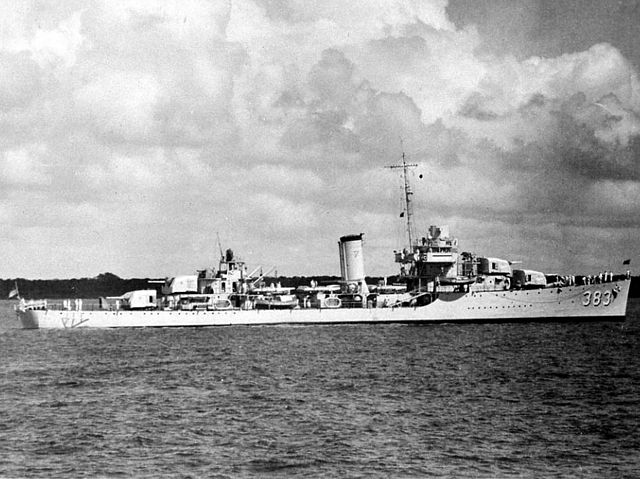
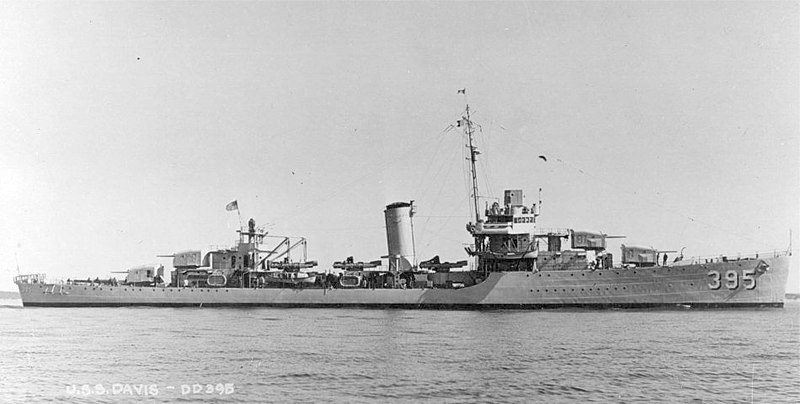

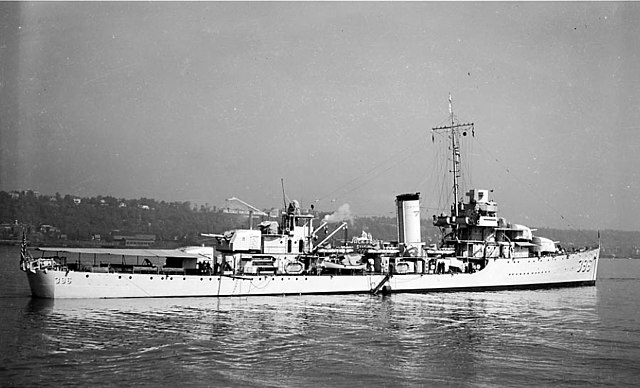
3D model
The Somers class destroyers in service
 USS Somers (DD381)
USS Somers (DD381)
USS Somers was built at Federal, Kearny (New Jersey), commissioned at the New York NyD on 1 December 1937. After sea trials and working out, shakedown cruiser, she was tasked to carry a consignment of gold from the Bank of England to New York. On 6 November 1941 with USS Omaha while patrolling the Atlantic (netrality patrols) she captured the German freighter Odenwald carrying 3800 tons of scarce rubber and disguised as the US merchantman Willmoto.

In November 1942, USS Somers, wtill with USS Milwaukee (CL-5) and USS Cincinnati (CL-6) intercepted the German blockade runner Anneliese Essberger, near Brazil.
In January 1943, USS Somers and Memphis (CL-13) were sent to Bathurst, Gambia (West Africa) as an escort for the Casablanca Conference. Next, she was relocated to the now Free French base of Dakar, Senegal, escorting Richelieu and Montcalm to the United States for an overhaul. By March 1943, she was based in Trinidad, patrolling off the Brazilian coast.
On 1st January 1944 she intercepted the German blockade runner Westerland. In May 1944, she escorted a convoy to Britain to prepare for D-Day. She also took part in the invasion of Normandy, stil as escort.
By August 1944 she took part in Operation Anvil Dragoon, the Southern France invasion. She rpovided naval gunfire and close support as well as ASW patrols when it was over. On 15 August 1944, already she spotted and sank the German corvette UJ6081 and sloop SG21 at the Battle of Port Cros. Her gunnery support lasted for two days near Toulon and she also duelled with German shore batteries east of Marseilles, taking some damage in return.
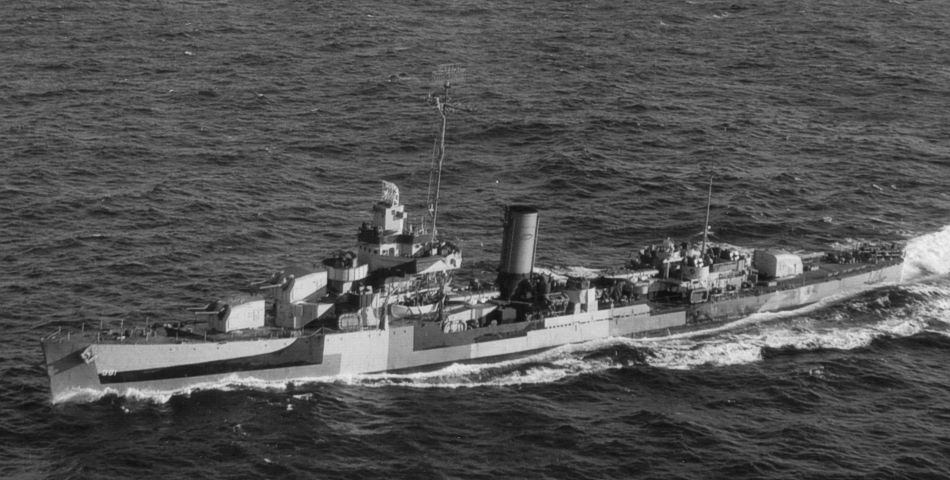
In September 1944, USS Somers stayed in the Mediterranean Sea, patrolling and stopping in Ajaccio, and Oran. She departed from there on 28 September for New York, to be overhauled at the Brooklyn Navy Yard, until 8 November. After a refresher training at Casco Bay she joined another convoy to Britain on 23 November, making four transatlantic escort missions until back to New York on 12 May 1945, and spent the remainder of the war training off the eastern seaboard. By July 1945 she made a summer cruise to the Caribbean with midshipmen.
On 4 August 1945 she returned in Charleston for a short overhaul, until 11 September. After that she reported to the 6th Naval District for decommissioning, which was done at Charleston on 28 October 1945. She was sold to Boston Metals of Baltimore on 16 May 1947, stricken in January.
 USS Warrington (DD383)
USS Warrington (DD383)
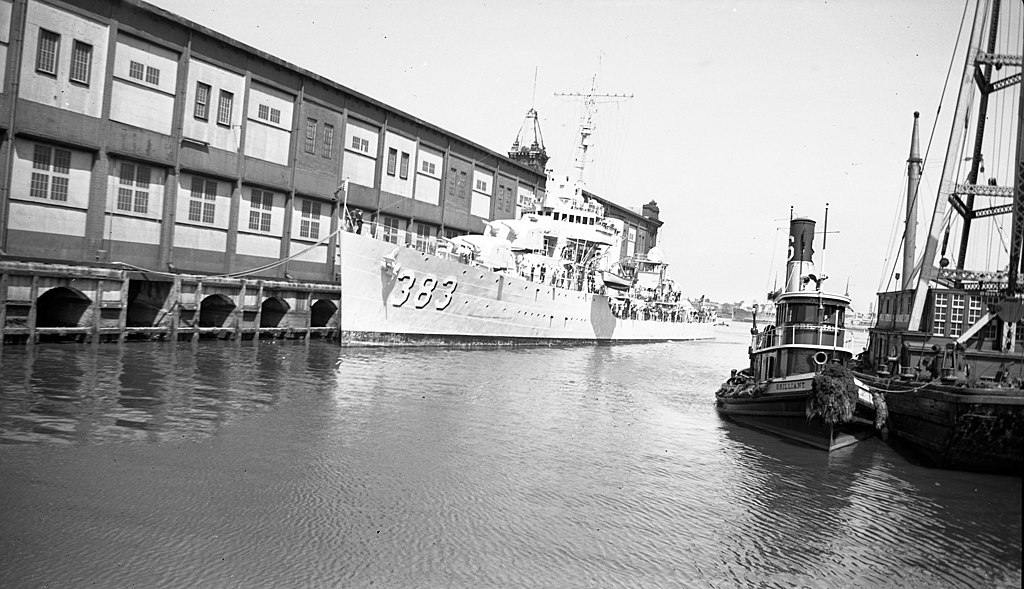
USS Warrington prewar.
Named after Lewis Warrington, and officer made famous during the raid on the Barbary coast in 1812, she was built at Federal Shipbuilding and Drydock Company, launched 15 May 1937 and commissioned on 9 February 1938. After sea trials, she did her shakedown cruise to the West Indies bt April–May 1938, and was in New York City for post-shakedown availability, tactical training off Cape Cod, maneuvers with SubDiv 4 off New London. and by October a refresher training off Cuba.
On 4 December, she was based in Rhode Island at the head of DesDiv 17, DesRon 9, training with USS Enterprise and Yorktown for Fleet Problem XX.

USS Warrington underway in Las Perlas Archipelago, Panama 23 April 1943
February 1939, saw her at Key West, escorting the cruiser carrying Pdt. Franklin D. Roosevelt and CNO Admiral William D. Leahy assiting to the 1939 annual Fleet exercise. She ended at Charleston by 3 March. By 9 June at Fort Hancock (New Jersey) she embarked King George VI and Queen Elizabeth for passage to Manhattan. At Norfolk on 26 June she crossed the Panama Canal for San Diego and later took part in Fleet Problem XXI off Hawaii. She remained in Pearl Harbor and trained along the east coast until April 1941 for Fleet exercises, being in Pearl by December 1940.
From 18 April 1941 she took part in the Atlantic “Neutrality Patrol” with the cruisers Cincinnati, Memphis, and her sister USS Davis, on the eastern Caribbean and western Atlantic, cut by escort missions, like escorting SS Acadia from Recife in Brazil to Puerto Rico. She returned to San Juan on 3 November, stopped in Norfolk and entered Charleston for an overhaul.
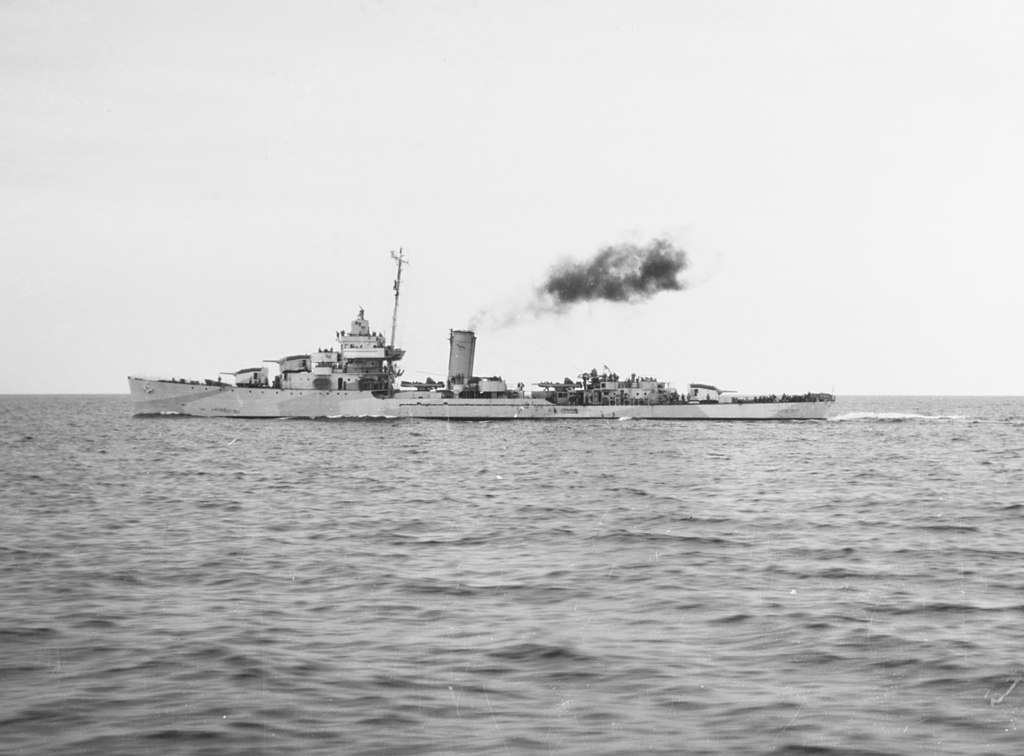
USS Warrington off Panama 23 April 1943
After the attack on Pearl Harbor she resimed patrols along the Atlantic coast, from Norfolk to Newport. She later escorted HMS Duke of York into Norfolk. By January 1942 she ws transferred to the southern sector, from Balboa, Panama Canal and retransferred to the Southeast Pacific Force.
She patrolled there for next 16 months, escorting merchant/supply/troopships between Panama and the Society Islands, and patrolled the southeastern Pacific shores down to Callao in Peru. She also ocasionally served as target and training ship for submarines or Army patrol bombers. By December 1942, she escorted USS South Dakota heavily damaged after the Naval Battle of Guadalcanal into Balboa and to New York. By 23 May she escorted her last convoy to the Society Islands, stopping at Bora Bora on 4 June for new orders.
She was redeployed closer to action in the southwestern Pacific, from Nouméa in New Caledonia and rededployed to Australia, Samoa, Hawaii, Guadalcanal, and the New Hebrides for various convoy missions. She notably escorted the Bougainville invasion force, which gave her AA gunners the occasion to fire on IJN air raids, claiming sole credit for downing the first plane and assisted for the second. She made runs between Guadalcanal and Espiritu Santo and in March was part of the ASW screen for an escort carrier task group supporting TF 37 striking at Kavieng. She escorted ships to Emirau Island, to the New Hebrides, and by April joined TF 37 at Efate and to Sydney, the back to Efate, Havannah Harbor in May to team with USS Balch to New Guinea, Milne Bay, Capes Sudest and Cretin. She escorted LSTs there into Humboldt Bay and on the 25th, made a shore bombardment mission at Wakde Island for the 6th Army.
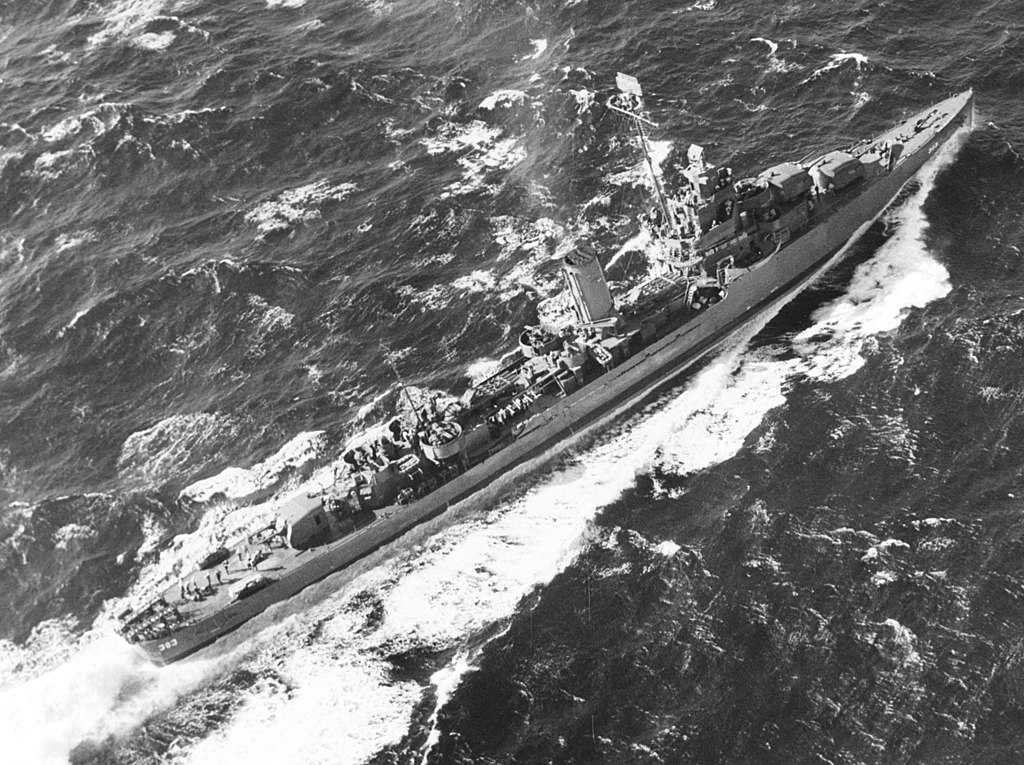
USS Warrington underway 9 August 1944
After a stop at Hollandia she escorted other LSTs to Biak Island, also assigned to a shore fire control group. She returned with TG 77.8 at Humboldt Bay and returned in June in Biak for support. She was also seen in Manus, Admiralties, Espiritu Santo and returned to the United States with Balch via via Bora Bora and Panama Canal, to New York for an overhaul concluded in August, a refresher cruise off Maine, more modifications at Norfolk Navy Yard. While underway off the Florida coast she was signalled an inpending hurricane, but rode relatively well through, but it worsened and she was flooded on 13 September, cutting her electrical power, main engines, steering engine while trying to reach Hyades. She launched a distress call but by noon orders were given to abandon ship. At around 12:50, her crew evacuated, she was completely flooded and sank. The crew was searched by USS Hyades, Frost, Huse, Inch, Snowden, Swasey, Woodson, Johnnie Hutchins, ATR-9 and ATR-62 which rescued only 5 officers and 68 men. She was stricken on 23 September 1944.
 USS Sampson (DD384)
USS Sampson (DD384)
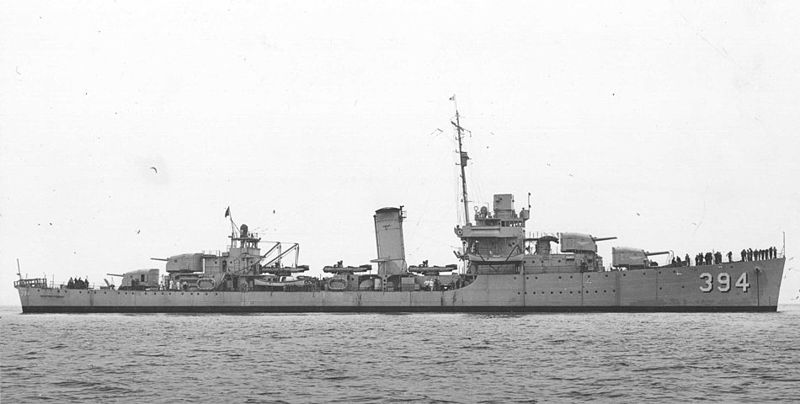
Built at Bath Iron Works, USS Sampson, 2nd of the name, was launched 16 April 1938 and Commissioned on 19 August. After sea trials and a shakedown cruiser in European waters (October-November) she headed to Boston, assigned to the Battle Force and taking part from March 1939 to combined fleet maneuvers off Cuba-Puerto Rico. By 20 April she was redircted to the west coast, San Diego, on 12 May, followed by fleet tactics, combined battle practice off the Hawaiian Islands until 20 June 1940. By December she carried a government mission compiling an economic survey of the British West Indies.
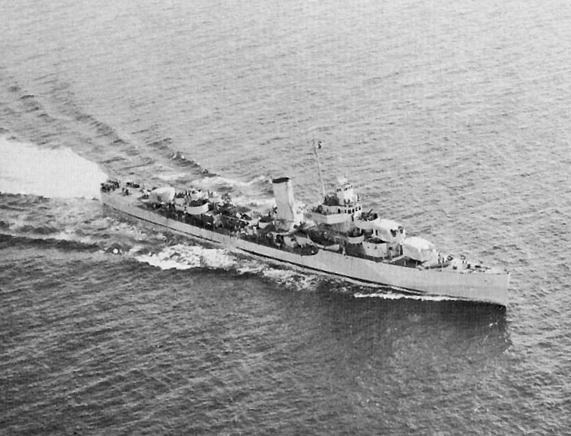

Part of the Neutrality Patrol on the eastern seaboard from the Carribean to Newfoundland, by 3 September 1941 she was off Boston, ASW patrolling on the shipping lanes and went to Hvalfjordur in Iceland, back to Boston on 4 November and escorting convoy HX 153 (7-13 Oct) and ON 28 until 3 Nov 1941. By December, she was patrolling with USS Warrington off Newport in Rhode Island, from December 1941 to 12 January 1942 until reaching Panama and transiting to the Southeast Pacific Forces. They tried to located the sunken USS S-26 lost on 24 January after a surface collision off Panama Bay.
She escorted twelve troopships in February and arrived in Bora Bora, joined USS Trenton back to Panama, Balboa in March. She made a serie of coastal patrols from Balboa to South America, down to Callao, Peru and between the Society and Galapagos Islands. This ended on 7 May 1943, and she was sent to New Caledonia by June, escorting troopships in June-July. From Pago Pago in Samoa, she joined her sister USS Warrington back to Pearl Harbor. On 27 July both escort four Army troopships for Australia, Sydney, and proceeded later to New Caledonia and edscorting ships from there to Espiritu Santo but also Guadalcanal, Purvis Bay, Florida and the Solomon Islands. On 2-3 October she located and fired on an IJN submarine, which submerged, depth charges her, but no kill.

Sampson underway in the Gulf or Panama, 14 March 1943
By March 1944 USS Sampson escorted USS Natoma Bay (CVE-62) and Manila Bay (CVE-61) for a raid on Kavieng in New Ireland on 20 March also covering the 4th Marine Regiment. Later she escorted a convoy at Port Purvis, Florida Island to the Solomons and to Espiritu Santo. She escorted in April troopships to Borgen Bay in New Britain and was in Milne Bay on 11 May. Joining the 7th Fleet in New Guinea by 20 May she became flagship, Rear Admiral W. M. Fechteler of TF 77. She was in late May visited by Major General Horace H. Fuller, 41st US Army Division with his staff to confer with Fechteler for an amphibious assault on Biak Island, Schouten Islands. After the naval bombardment in which she took part, the first wave landed. On the 27th they were attacked by four twin-engined Japanese aircraft, all destroyed, but the 4th attempted to crash into Sampson, passed just over her bridge before hitting the water, but sliding into SC-699, badly damaging her. Sampson later moved to Humboldt Bay.
She later returned in the Canal Zone, returned with the Atlantic Fleet on 25 June, escorted the troopship General Tasker H. Bliss to New York and on 4 July started an overhaul. She became flagship of Capt. H. T. Read from TF 63 in Hampton Roads and started new transatlantic convoy-escort duties, notably escorting Convoy UGS-49 to Bizerte in Tunisia, 13 August and back to NYC. From September 1944 and into May 1945, she multiploed these escorts. She was in Boston on 19 May until 1 July, moved to Annapolis, Maryland to carry midshipmen for a training cruise and battle practice off Cuba and the Virginia Capes, until 30 July. From Norfolk on 19 August she trained off Guantanamo Bay before being inactivated in Philadelphia Naval Shipyard on 16 September, decommissioned on 1 November 1945, struck on 28 November and sold for BU on 29 March 1946. She earned a single battle star for her service.
 USS Davis (DD 385)
USS Davis (DD 385)
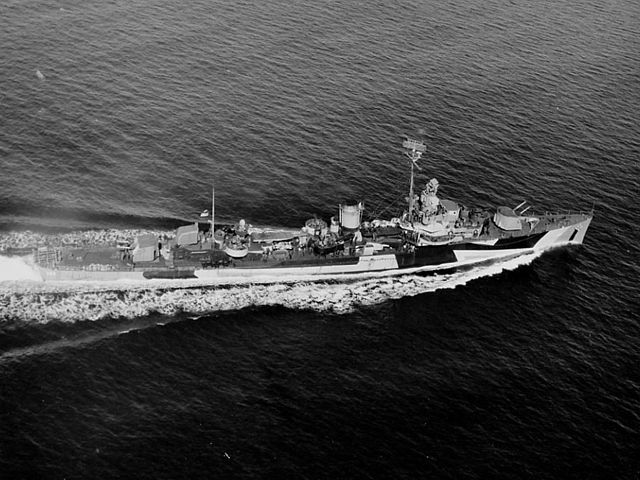
Built at Bath Iron Works, USS Davis (after Charles Henry Davis, civil war admiral), she was laid down on 28 July 1936, launched on 30 July 1938 and Commissioned on 9 November 1938. After sea trials, shakedown cruise in the Carribean, fleet training and drills, she was assigned to Neutrality Patrols in the North Atlantic from September 1939. On 13 November, she sailed from Boston to Galveston and from there patrolled in the Gulf of Mexico, alternated with training exercises. She transited on the west coast from 11 March 1940 to 26 April 1941 and back to the Caribbean until december 1941.
USS Davis escorted ships and patrolled along the east south american coast, notably from Recife, Brazil. On 19 July 1942 she rescued 10 men from the torpedoed British sailing ship Glacier. On 19 December 1943 she went on from Recife. She captured the German blockade runner Burgenland on 7 January 1944. Next, she was sent in New York on 15 April 1944 for a refit, while escorting USS Franklin (CV-13).

USS Davis, DD-395, underway in 1945
She sailed for Britain on 14 May as a convoy escort, arriving at Plymouth on the 25th. On 5 June she was underway from Milford Haven in Wales with a convoy in preparation to the invasion of Normandy. She arrived on 7 June and during a patrol, duelled with a German E-boat. She made trips from Devonport to the Baie de Seine, Normandy un June and on the 21th she hit a mine, having her whole port quarter badly damaged. She survived. She made emergency repairs and sailed to the Isle of Portland, for further repairs and afterwars to Charleston in South Carolina on 11 August for permanent repairs, which were double bt a full reconstruction as seen above, along the lines of the rebuilt ships of the Ported class, Selfridge and Phelps.
She was back to her last convoy escort missions by 26 December 1944, until 21 June 1945, making foursuch trips between New York and Britain.
After her last one, she was sent to Norfolk, Virginia on 10 July, awaiting her fate. She was decommissioned on 19 October 1945 and was sold for BU on 24 November 1947.
 USS Jouett (DD389)
USS Jouett (DD389)
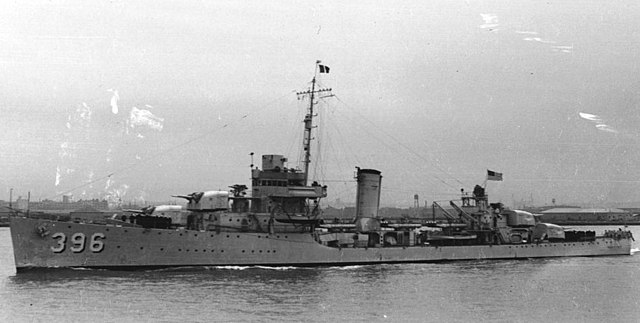
USS Jouett (after Rear Admiral James Edward Jouett (1826–1902) “Fighting Jim Jouett of the American Navy” of the Mexican–American War and the American Civil War) was built at Bath Iron Works in Maine, laid down on 26 March 1936, launched 24 September 1938 and commissioned on 25 January 1939.
After sea trials, shakedown and training where she sailed to England and Ireland and back to Norfolk on 29 April 1939, USS Jouett started Neutrality Patrols along the East and the Gulf of Mexico. On Pensacola Bay by 15 February 1940 she escorted USS Tuscaloosa with President Franklin D. Roosevelt aboard on a cruise to the Gulf of Panama and back to Pensacola by 1st March 1940. She went back to the Panama Canal, crossed and reported for dury in Pearl Harbor on 10 April 1940.
During the whole of 1941 and until the attack she trained extensively as aircraft carrier screen ship, perfecting tactics. By 18 April she escorted USS Yorktown through Cuba and then Spain, Trinidad, on 19 May. Next she joined a composite force under Rear Admiral Jonas H. Ingram guarding against German surface or submarine attacks on the Atlantic. Jouett was at Port of Spain when the attack on Pearl Harbor started, and was undergoing ASW patrols between Brazil and Africa. She carried Army engineers to Ascension Island on 30 March 1942 to built an airfield. She escorted oil tankers from Trinidad, havinbg U-Boat spots and attacks along the way. By December 1942 she was in Charleston for an overhaul. By 21 January 1943 she was back escorting ship to and from Natal, Brazil.
There she hostedd President Getúlio Vargas on 27 January 1943 for a conference on board USS Humboldt, with President Roosevelt, which brought closer naval cooperation. Jouette resumed escort duties in February and by 14 May looked for U-128 signalled off Bahia, Brazil. Eventually the chased under with the sub, under constant air attack, surfaced and sunk by gunfire from USS Jouett and Moffett. Still with Admiral Ingram’s 4th Fleet she served for the remainder of 1943.
By January 1944 she patrolled with USS Omaha, intercepting the German blockade runner SS Rio Grande with crude rubber aboard. On 5 January patrol planes reported “floridian”, and unknown ship later identified as the blockade runner Burgenlund. Both US ships caught her by radar, vectoring aerial attacks and they closed in, ad while the crew placed Scuttling charges she was sunk by gunfire after 17:30.
USS Jouett was back in Charleston by March 1944 for training operations in Casco Bay (Maine) and an escort mission to England by May 1944. She was assigned newt to the Reserve Fire Support Group prepared for Operation Overlord. She arrived arrived off Omaha Beach on 8 June, escorting steamers and suppored troops ashore, repelling an air attack and by 21 June screened British heavy cruisers for a shore bombardment, providing ASW screen for the Omaha Beach area. More convoy escort missions followed to and front the Firth of Clyde, until 12 July 1944. Next she moved to Algeria, Oran and was prepared to take part in Operation Anvil Dragoon in southern France. From Naples on 14 August she was in the Delta assault area next, acting as command ship for the Convoy Control Group until 3 September. After patrolling off Toulon by left by early October for Cap Ferrat supporting by gunfore American troops ashore, destroying mines off San Remo on 9 October, bridges, and covering minesweeping operations.
From Oran on 31 December she returned to Charleston for an overhaul. After a refresher training in Casco Bay by April, she escorted another convoy to England and Cuba and by 15 August 1945, she was ordered to Philadelphia Naval Shipyard. She was decommissioned there on 1 November 1945, and scrapped in 1946. For her service she received 3 battle stars, making her the most decorated ship of the Somers class in WW2.
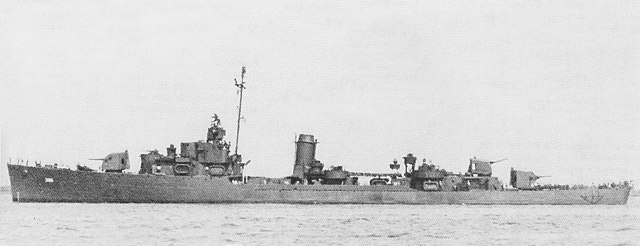
USS Jouett in August 1945

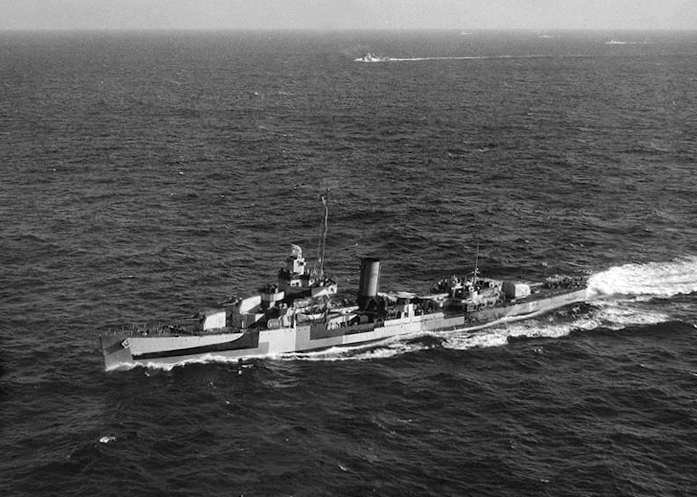

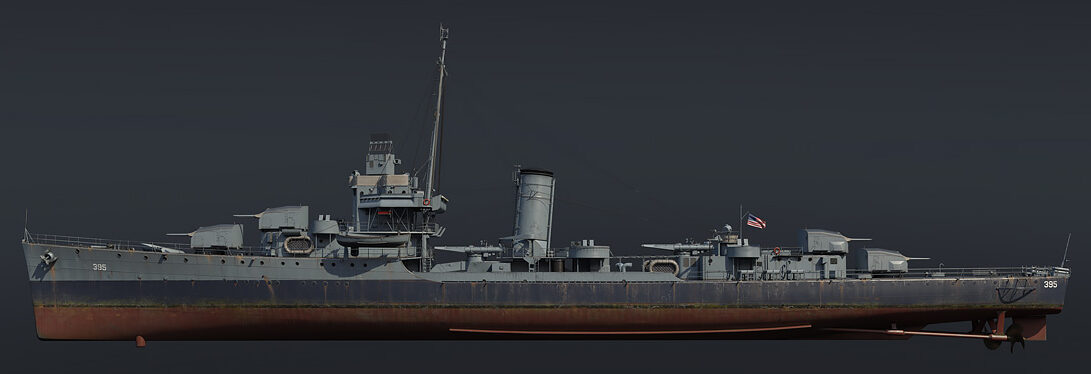
 Latest Facebook Entry -
Latest Facebook Entry -  X(Tweeter) Naval Encyclopedia's deck archive
X(Tweeter) Naval Encyclopedia's deck archive Instagram (@navalencyc)
Instagram (@navalencyc)





 French Navy
French Navy Royal Navy
Royal Navy Russian Navy
Russian Navy Armada Espanola
Armada Espanola Austrian Navy
Austrian Navy K.u.K. Kriegsmarine
K.u.K. Kriegsmarine Dansk Marine
Dansk Marine Nautiko Hellenon
Nautiko Hellenon Koninklije Marine 1870
Koninklije Marine 1870 Marinha do Brasil
Marinha do Brasil Osmanlı Donanması
Osmanlı Donanması Marina Do Peru
Marina Do Peru Marinha do Portugal
Marinha do Portugal Regia Marina 1870
Regia Marina 1870 Nihhon Kaigun 1870
Nihhon Kaigun 1870 Preußische Marine 1870
Preußische Marine 1870 Russkiy Flot 1870
Russkiy Flot 1870 Svenska marinen
Svenska marinen Søværnet
Søværnet Union Navy
Union Navy Confederate Navy
Confederate Navy Armada de Argentina
Armada de Argentina Imperial Chinese Navy
Imperial Chinese Navy Marinha do Portugal
Marinha do Portugal Mexico
Mexico Kaiserliche Marine
Kaiserliche Marine 1898 US Navy
1898 US Navy Sovietskiy Flot
Sovietskiy Flot Royal Canadian Navy
Royal Canadian Navy Royal Australian Navy
Royal Australian Navy RNZN Fleet
RNZN Fleet Chinese Navy 1937
Chinese Navy 1937 Kriegsmarine
Kriegsmarine Chilean Navy
Chilean Navy Danish Navy
Danish Navy Finnish Navy
Finnish Navy Hellenic Navy
Hellenic Navy Polish Navy
Polish Navy Romanian Navy
Romanian Navy Turkish Navy
Turkish Navy Royal Yugoslav Navy
Royal Yugoslav Navy Royal Thai Navy
Royal Thai Navy Minor Navies
Minor Navies Albania
Albania Austria
Austria Belgium
Belgium Columbia
Columbia Costa Rica
Costa Rica Cuba
Cuba Czechoslovakia
Czechoslovakia Dominican Republic
Dominican Republic Haiti
Haiti Hungary
Hungary Honduras
Honduras Estonia
Estonia Iceland
Iceland Eire
Eire Equador
Equador Iran
Iran Iraq
Iraq Latvia
Latvia Liberia
Liberia Lithuania
Lithuania Mandchukuo
Mandchukuo Morocco
Morocco Nicaragua
Nicaragua Persia
Persia San Salvador
San Salvador Sarawak
Sarawak Uruguay
Uruguay Venezuela
Venezuela Zanzibar
Zanzibar Warsaw Pact Navies
Warsaw Pact Navies Bulgaria
Bulgaria Hungary
Hungary

 Bundesmarine
Bundesmarine Dutch Navy
Dutch Navy Hellenic Navy
Hellenic Navy Marina Militare
Marina Militare Yugoslav Navy
Yugoslav Navy Chinese Navy
Chinese Navy Indian Navy
Indian Navy Indonesian Navy
Indonesian Navy JMSDF
JMSDF North Korean Navy
North Korean Navy Pakistani Navy
Pakistani Navy Philippines Navy
Philippines Navy ROKN
ROKN Rep. of Singapore Navy
Rep. of Singapore Navy Taiwanese Navy
Taiwanese Navy IDF Navy
IDF Navy Saudi Navy
Saudi Navy Royal New Zealand Navy
Royal New Zealand Navy Egyptian Navy
Egyptian Navy South African Navy
South African Navy






























 Ukrainian Navy
Ukrainian Navy dbodesign
dbodesign